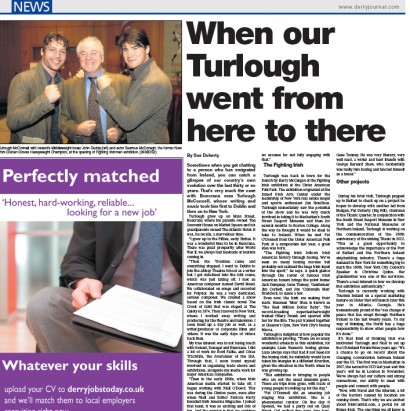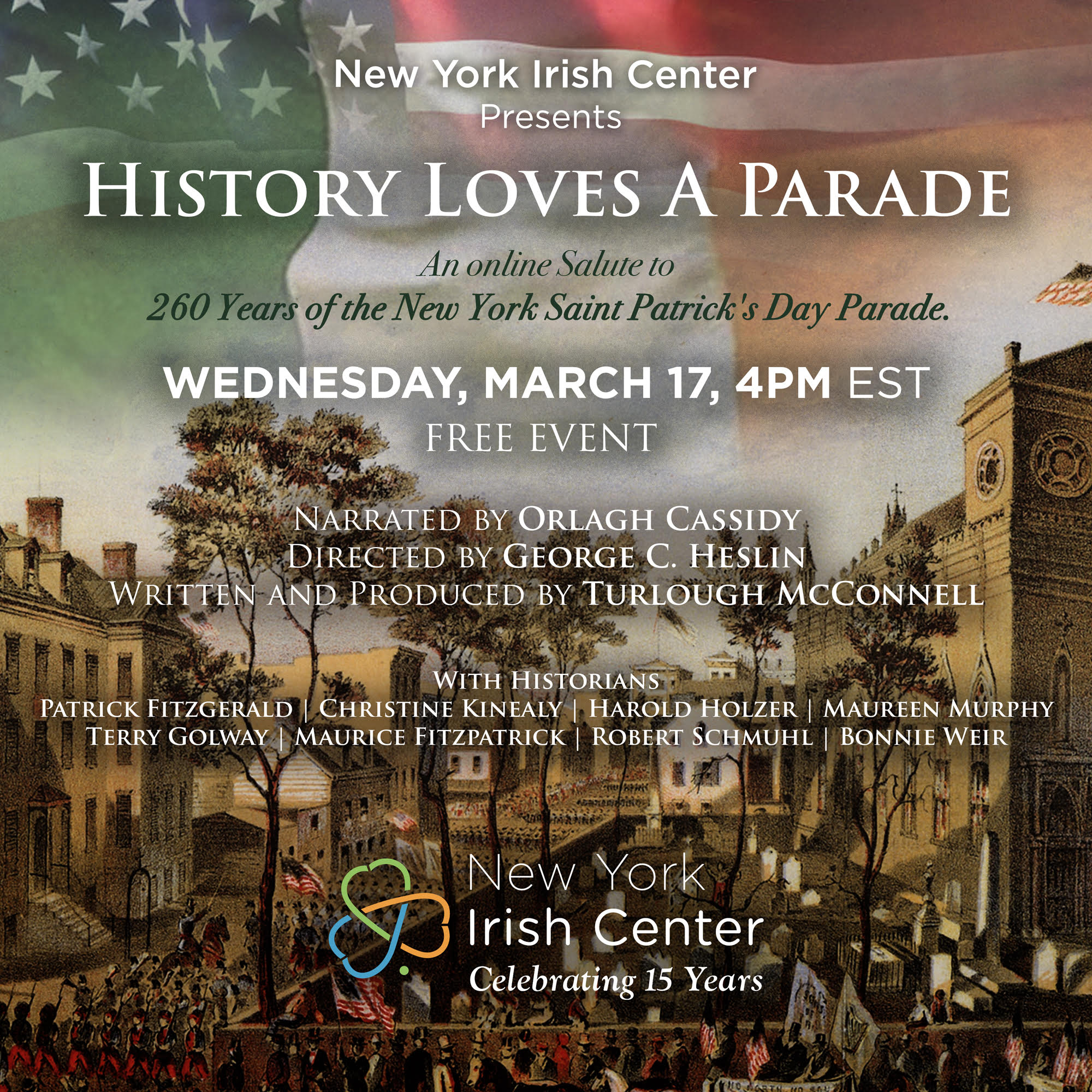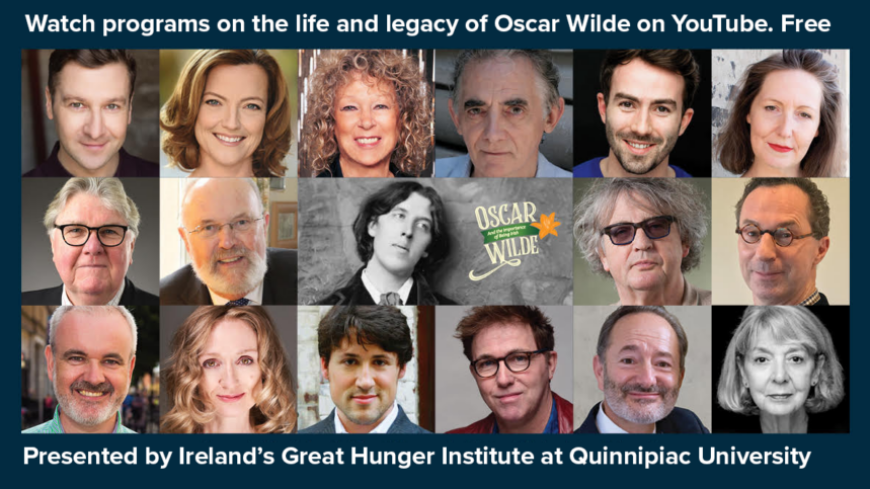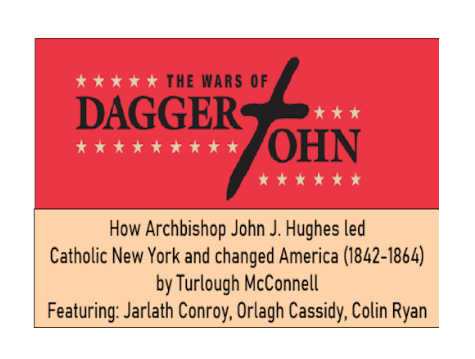Celebrating 250 Years of the New York City St. Patrick’s Day Parade.
November 10, 2012 Posted in Uncategorized | Comments Off on Celebrating 250 Years of the New York City St. Patrick’s Day Parade.New Quinnipiac Museum Commemorates Ireland’s “Great Calamity”
November 5, 2012Strictly From Hunger
New Quinnipiac Museum Commemorates Ireland’s “Great Calamity”
The opening of the new museum is typically a cause for celebration. But what about when the museum’s purpose is to memorialize a profound tragedy?
Quinnipiac University is opening Ireland’s Great Hunger Museum, Musaem an Ghorta Mhoir (in Gaelic) October 11 in a 5,000-square-foot renovated former library on Whitney Avenue in Hamden, just around the corner from the school’s campus at the foot of sleeping Gaint State Park.
The museum is devoted entirely to showcasing Irish art depiciting the events and circumstances surrounding the Great Famine of 1845-1852 (popularly referred to as the Irish Potato Famine). It houses one of the biggest collections of art relevant to the period in the world.
Click here to view the full article …
Posted in news | Comments Off on New Quinnipiac Museum Commemorates Ireland’s “Great Calamity”An Gorta Mór The Quinnipiac University Collection
September 22, 2012 Posted in Uncategorized | Comments Off on An Gorta Mór The Quinnipiac University CollectionQuinnipiac Announces Ireland’s Great Hunger Museum
September 15, 2012An Gorta Mόr
Quinnipiac President John L. Lahey today announced Ireland’s Great Hunger Museum at 3011 Whitney Avenue, near the University’s campuses in Hamden, will open and be officially dedicated at an invitation-only ceremony on Friday, Sept. 28.
Lahey made the announcement at a July 12 dinner to honor DruidMurphy’s acclaimed production for the Lincoln Center Festival of Tom Murphy’s “Famine” at the Gerald W. Lynch Theater, John Jay College. Quinnipiac co-sponsored the production.
“Museam An Ghorta Mór: Ireland’s Great Hunger Museum is home to the world’s largest collection of visual art, artifacts and printed materials relating to the starvation and forced emigration that occurred throughout Ireland from 1845 to 1852,” said Lahey, who has been widely‐honored for his visionary leadership in assembling the collection, begun in 1997 when he was grand marshal of the New York City St. Patrick’s Day Parade. The Consulate General of Ireland exhibited the collection in 2010.
The collection focuses on the famine years when blight destroyed virtually all of Ireland’s potato crops for consecutive years. The crop destruction, coupled with British governmental indifference to the plight of the Irish, who at the time were part of the United Kingdom, resulted in the deaths of 1.5 million Irish men, women and children and the emigration of more than two million to nations around the world. This tragedy occurred even though there was more than adequate food in the country to feed its starving populace. Exports of food and livestock from Ireland actually increased during the years of the Great Hunger.
Works by noted contemporary Irish artists will be featured at the museum, including internationally‐known sculptors John Behan (Famine Ship, the Irish national famine memorial), Eamonn O’Doherty (Westchester famine memorial) and Rowan Gillespie; as well as contemporary visual artists, Brian Maguire, Hughie O’Donoghue, Robert Ballagh and Alanna O’Kelly. Featured paintings will also include several important 19th and 20th‐century works by artists such as Jack B. Yeats, James Brenan, James Arthur O’Connor and Daniel MacDonald.
The museum will preserve, build and present its art collection in order to stimulate reflection, inspire imagination and advance awareness of Ireland’s Great Hunger and its long afterlife on both sides of the Atlantic.
Museum programs, including tours of the collection, discussions, films, plays and concerts, will educate the general public, academics, researchers, artists and students about the richness of Irish culture and the high quality of its visual arts in particular.
The museum will offer a unique opportunity for people of all ages and backgrounds to explore the largely unrepresented, unspoken and unresolved causes and consequences of the Great Hunger, this tragedy, as well as to appreciate the art that it continues to inspire.
A week‐long program of cultural and academic events culminating in a Dedication Day on Friday, Sept. 28 will mark the museum’s official opening.
“The building, which houses our new museum, was purchased after the success of the New York show and dates from the late 19th century when it was originally used as Hamden’s first free public library,” Dr. Lahey said. “After some significant renovation, it’s perfect for its new use, and we very much look forward to presenting it to the world.”
http://theirishrising.
Exhibitions and Museums
September 15, 20121916 – 2016: Proclaiming the American Story (2016)
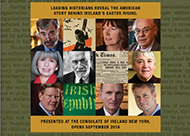
Curator
The Consulate General of Ireland, New York
1916 – 2016: Proclaiming the American Story, is currently on view at The Consulate General of Ireland, New York. Portraits of contemporary Irish-American historians with a selection of historic images and text create an American perspective of Ireland’s struggle for Independence.
Click here to learn more about this exhibition and related publications
How the Nuns of New York Tamed the Gangs of New York (2015)

Curator
Basilica of St. Patrick’s Old Cathedral
How the Nuns of New York Tamed the Gangs of New York, was on view at the Basilica of St. Patrick’s Old Cathedral, New York as part of the shared Bicentennial Celebration of the founding of the Sisters of Charity New York and the construction of the Basilica of St. Patrick’s Old Cathedral.
Click here to read Turlough McConnell’s related article on Irish Central
A Monumental Legacy: Archbishop John J. Hughes and The Building of St. Patrick’s Cathedral (2014)

Curator
St. Patrick’s Old Cathedral Gallery
A Monumental Legacy, continued its exhibition run at St. Patrick’s Old Cathedral Gallery, New York as part of the Bicentennial Celebration of the construction of the Basilica of St. Patrick’s Old Cathedral.
Click here to view original video content and to learn more about this exhibition
A Monumental Legacy: Archbishop John J. Hughes 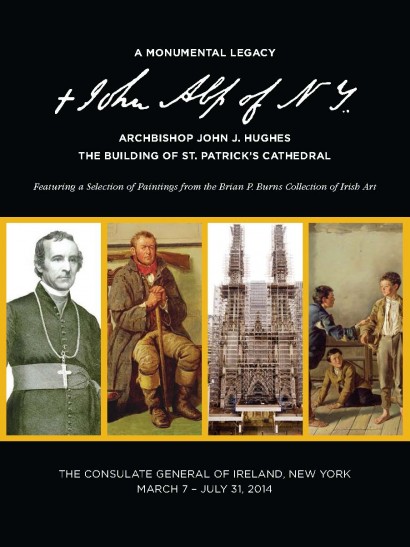
and The Building of St. Patrick’s Cathedral (2014)
Curator
The Consulate General of Ireland
March 7 – July 31, 2014
Archbishop John J. Hughes and The Building of St. Patrick’s Cathedral featuring a selection of paintings from the Brian P. Burns Collection of Irish Art. The extraordinary story of a towering 19th century Irish immigrant and the Famine Irish who built a New York landmark.
Click here to view original video content and to learn more about this exhibition
Ireland’s Great Hunger Museum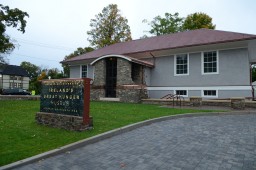
Músaem an Ghorta Mhóir
Special Adviser/Executive Producer
Ireland’s Great Hunger Museum, Músaem an Ghorta Mhóir, is the world’s largest collection of art and sculpture relating to the catastrophe that devastated Ireland from 1845–52. There are only a handful of public institutions in Ireland that tell the story of Ireland’s Great Hunger. With the opening of this museum, there is now one in North America, home to so many generations of descendants of Famine immigrants.
The mission of the museum is to educate people of all ages, using world-class art, about that traumatic period of 19th-century Irish life. It is the vision of Quinnipiac University, and its president, John L. Lahey, that the museum will become a center of artistic and academic excellence—collecting great works of art, conducting tours and hosting discussions, films, plays, and concerts to showcase the richness of Irish culture and ideas.
Click here to view the exhibition’s catalog
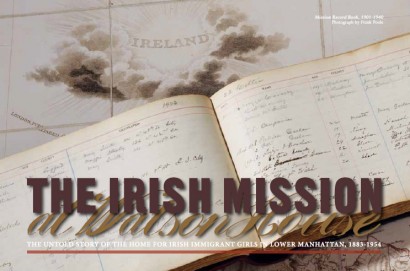 The Irish Mission at Watson House: Reopened After Hurricane Sandy (2012-2014)
The Irish Mission at Watson House: Reopened After Hurricane Sandy (2012-2014)
Exhibition Producer
Currently at Watson House
Facing the harbor and Staten Island, and across from Battery Park, Watson House is one of the very few colonial buildings still standing in the City of New York. The front columns built from ship masts were expressive of the successive sea merchant owners, starting with import/exporter and civic leader, James Watson. The United States government used the building during the Civil War and after the war the Harbor’s Pilot Commissioners made their headquarters there. On December 4, 1885 the house was sold to Rev. John J. Riordan who established the Home of the Mission of Our Lady of the Rosary for the Protection of Irish Immigrant Girls on the site.
The post-famine (1845-52) Irish custom of giving the land to one inheriting son and dowering one daughter meant that many non-inheriting sons and daughters emigrated. Irish emigration was unique in that it was an emigration of siblings with women frequently outnumbering the men. A second agricultural depression that began in 1879 further stimulated emigration and created conditions that led to the creation of a mission to serve young women who emigrated alone. Mission agents met Irish immigrant women when they landed, assisted them with meeting relatives and friends and brought those who needed further assistance or accommodation to the Mission.
Click here to view the exhibition’s brochure
80 Years of Service Exhibition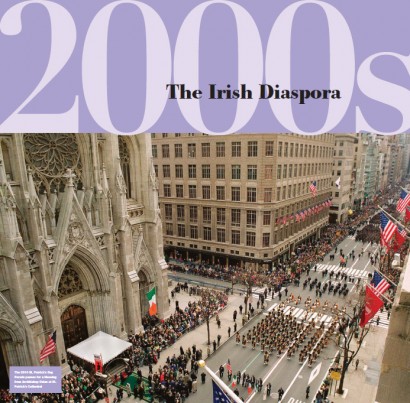
At the Consulate of Ireland: A Traveling Exhibition (2012-2014)
Curator
Currently at NY Irish Center
Created for the Consulate General of Ireland
Through a series of eight wall panels, Curator Turlough McConnell interprets each decade of the last eighty years in Irish and American history, culture, and photographs. Each Irish Consul General and Grand Marshall of the St. Patrick’s Day Parade is listed, along with New York’s mayors and governors, American and Irish Presidents and each Irish Taoiseach, with their years of service.
Click here to view the exhibition’s panels
 Fighting Irishmen: Celebrating Celtic Prizefighters
Fighting Irishmen: Celebrating Celtic Prizefighters
1820 to the Present: A Traveling Exhibition (2006-2013)
International Producer
Currently at the Irish Center in Pheonix, AZ
Organized by the Irish Arts Center and curated by collector James J. Houlihan, The exhibit first opened in 2006 at the Irish Arts Center, moved to the South Street Seaport Museum in lower Manhattan (2007), the Burns Library at Boston College (2008), the Ulster American Folk Park in Omagh, Ireland (2009), Croke Park at the GAA Museum in Dublin, Ireland (2010), University of Limerick (2011), and the Irish Center in Pheonix, AZ (2013).
The exhibition features as its central piece, the late, great Irish fighter Dan Donnelly’s mummified right arm and an array of robes, gloves, boxing bags, prints, photographs, paintings, and film footage of Celtic prize-fighters from 1820 to the present day. Other objects on display include pieces from sporting greats such as John L. Sullivan, Jack Dempsey, Gene Tunney, Barry McGuigan, Freddie Gilroy, Bobby Cassidy, Gerry Cooney, Billy Graham, Billy Conn, John Duddy, Maureen Shea, Steve Collins, Andy Lee, and many more. Ballymena-born actor Liam Neeson, Honorary Chair and long-time supporter of the Irish Arts Center, has also loaned personal items from his amateur boxing career to the exhibit including the gloves given to him by Olympic boxer Freddie Gilroy.
Click here to be taken to the exhibition’s website
Ireland’s Great Hunger: Exhibition (2010)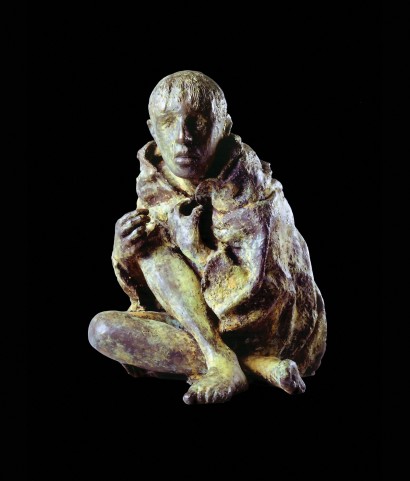
Curator and Producer
The Great Hunger ranks among the worst tragedies in the sweep of human history. Between 1845 and 1850, approximately 1.5 million Irish men, women and children died of starvation or related diseases. By 1855, more than two million more fled Ireland to avoid a similar fate. In a single decade, Ireland’s population dropped by half, from eight to four million, and continued to decline for the rest of the century. By 1900, only two million people remained in Ireland. Indisputably the worst chapter in Ireland’s history, The Great Hunger occurred during an era of sufficiency: There was more than adequate food in the country to feed its starving populace. Exports of food and livestock from Ireland actually increased during those years.
The exhibition contains sculptures by such artists as John Behan, Glenna Goodacre, Rowan Gillespie, John Coll, Eamonn O’Doherty and Kieran Tuohy. Several pieces in the collection are maquettes, or miniatures, of Famine memorials that have been erected in recent years both at Irish ports where families embarked for new lands and at ports of entry in the United States and Canada where the Irish fled in desperation. Paintings, lithographs, photographs and etchings by artists including Padraic Reaney, Micheal Farrell and Kit DeFever are also featured.
Click here to see the exhibition’s brochure
Sculptured Lives Exhibition (2009)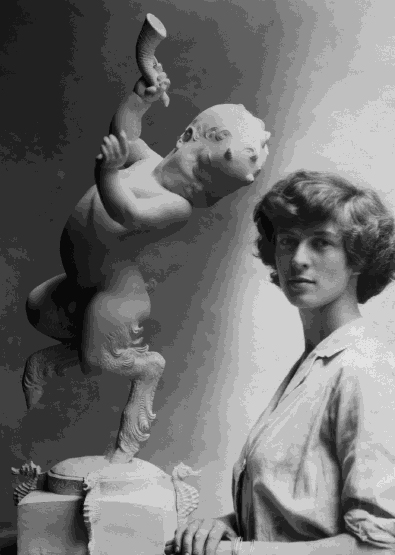
Producer
Sculptured Lives presents sculptured heads and figures, drawings, paintings, photographs and letters spanning over 50 years of Helen Hooker’s artistic career. The selections were drawn from the many works created by the artist since 1911. On view are books, letters, photographs and ephemera that tell the story of Helen and her Irish husband, IRA Commandant- General Ernie O’Malley, the soldier and writer. Also included are some of his books and rare letters to him from Eamon deValera and his artist friend, Jack B. Yeats. Family photographs feature his friends film director John Ford, and actress Maureen O’Hara.
A highlight of the exhibition is a rare film interview with Helen Hooker in 1973 and a recent documentary of Ernie O’Malley that premiered in 2008 on TnaG, Irish Television.
Click here to see a PDF of the exhibition’s catalog
Antwerp = America (2005)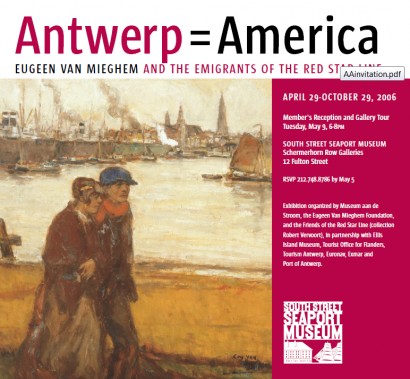
South Street Seaport Museum Producer
Between 1873 and 1934 three million emigrants left Europe for America, traveling with the Red Star Line from the port of Antwerp in Belgium. They were comprised of Belgians, Germans and Eastern Europeans, mostly Russian and Austro-Hungarian Jews.
The exhibition recounts the Antwerp part of the shipping line’s history between 1870 and 1930, a period of great economic prosperity. It features images of the Antwerp streets and quays, which the emigrants passed on their way from Central Station to Rijnkaai (Rhine Quay), where the Red Star Line ships set sail for the US. The highlight of this exhibition is the panoramic Hypsos Map, which dates back to 1913, and which depicts the city and its port in great detail. The map comes with an interactive program, which enables visitors to call up any information about Antwerp in 1913 and which also enables them to walk in the footsteps of the emigrants in Antwerp on screen. In addition the exhibition also displays ships’ models, posters, menus, furniture and old film fragments related to the Red Star Line.
Throughout the exhibition works by Belgian painter Eugeen Van Mieghem (1875-1930) are showcased. His parents owned a pub near the Red Star Line warehouses, and he became a witness and painter of the immigrants who left via Antwerp for the New World. His drawings and paintings evoke life in the port and the history of the immigrants. The South Street Seaport Museum is located in the historic port neighborhood of Lower Manhattan, near the Hudson River berths of the great immigrant steamships.
The exhibition is organized by the MAS [Museum aan de Stroom], the Eugeen Van Mieghem Foundation and the Friends of the Red Star Line (Collection Robert Vervoort), in partnership with South Street Seaport Museum, Ellis Island Immigration Museum, Consulate of Belgium in New York, Tourist Office for Flanders, Tourism Antwerp, Euronav, Exmar, Port of Antwerp and CMA CMG Belgium.
Click here to view more.
All Available Boats: Exhibition (2007)
World Tour Producer
In the days immediately following 9/11, the staff of South Street Seaport Museum came together to create an exhibition of “America’s Dunkirk,” the evacuation of more than 500,000 people from Lower Manhattan after the terrorist attacks. Ferries, yachts, and working vessels responded to the Coast Guard’s call for “All Available Boats.” Using previously unpublished personal photographs and recorded interviews with both rescuers and rescued, the exhibition was organized with support from the National Endowment for the Humanities and its world tour was underwritten by Pfizer.
Click here to order the exhibition’s catalog.
Posted in featuredhomeright, projects | Comments Off on Exhibitions and MuseumsFilm and Multimedia Presentations
September 14, 2012Ireland’s Great Hunger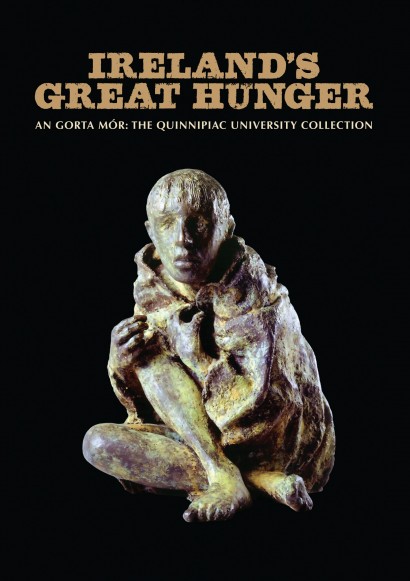
An Gorta Mór
The Quinnipiac University Collection
Writer/Director/Producer
Through the voices of Quinnipiac University President John Leahy, PhD, historians Christine Kinealy and David A. Vallone, librarian Janice Swiatek-Kelly, PhD, Galway booksellers Des and Tom Kenny, and artists John Behan, Pádraic Reaney and Kieran Tuohy, this film tells the haunting story of Ireland’s Great Hunger. Images of sculpture and painting, documents and maps help to evoke a time (1845-52) when a million and a half people died and over two million more fled, out of a pre-famine population of eight million. Within a decade, the population of Ireland was reduced by half.
This film is in limited release. To receive a copy by email, please click here.
The Brian P. Burns Collection of Irish Paintings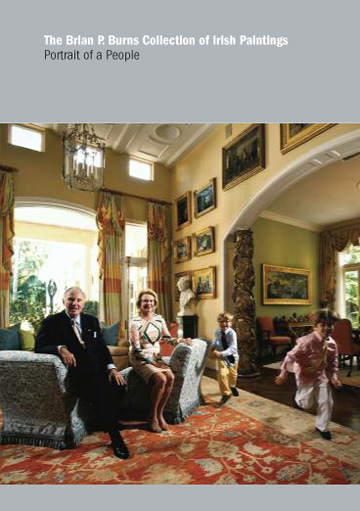
Portrait of a People
Writer/Director/Producer
Featuring over 100 important Irish paintings and watercolors from the mid-19th to mid-20th century, this film captures selections from The Brian P. Burns Irish Art Collection. This significant private collection was displayed and filmed at The Phoenix Art Museum in Phoenix, Arizona in 2007. Featured artists include William Orpen, Paul Henry, Jack B. Yeats, Walter Osborne and Sir John Lavery. By exploring the rise in awareness of Ireland’s painters among the Irish Diaspora, the Collection also serves as an historical record of the culture and identity of the Irish and their art.
Also presented in this film, is a selection of rare Irish books and original literary manuscripts from the John J. Burns Library’s Irish Collection, founded in memory of his father, including selected books, letters and manuscripts by W.B. Yeats, Jack Yeats, Samuel Beckett, George Bernard Shaw, Seamus Heaney, Flann O’Brien and Nuala Ni Dhomhnaill. The Burns Library’s Irish Collection is part of
the Center for Irish Programs at Boston College, which also includes the University’s acclaimed Irish Studies Program and Irish Institute.
This film had not yet been released. Please visit this site again for further information.
Treasures of New York: St. Patrick’s Cathedral
Contributor/Participant
Aired on Thirteen (PBS), August 15, 2015.
As the world awaits Pope Francis’s visit to New York, Treasures of New York, St. Patrick’s Cathedral delves into the cathedral’s history as the center of Catholic life in New York City, showcases the recent $175 million restoration, and examines the breathtaking architectural features that have made it a celebrated building and National Historic Landmark.
To view the full episode please click here
Joker at the Universe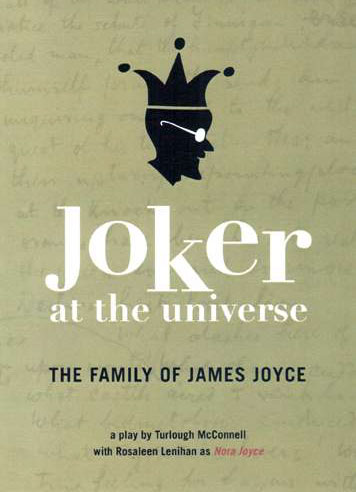
Writer
A play focusing on the end of James Joyce’s life and his family, written by Turlough McConnell and performed November 14th, 2003.
Please click here for more information.
Posted in featuredhomeright, projects | Comments Off on Film and Multimedia Presentations
Irish Dignitaries Dedicate Watson House Exhibition
September 13, 2012Home of the Irish Immigrant Girls in Lower Manhattan
Huffington Post
March 2, 2012
Forty-four faces stared out at us from a six-by-eight-foot enlargement of a black and white photograph taken in 1908. The images of young Irish immigrant women in their teens and twenties were both solemn and hopeful. These young women would become workers, mothers, and grandmothers, and would be the backbone of the Irish American community in New York and the United States.
Wednesday, February 29, 2012 was the official opening of a new exhibition produced by the Mission at Watson House at Our Lady of the Rosary Church in lower Manhattan. During the Ellis Island era, roughly 1890 to 1924, millions of European immigrants arrived in the United States. The church and the accompanying Watson House at 7 State Street provided greetings and safe haven for more than 100,000 young Irish girls who came to New York and the United States to work as servants. If there were no family members to greet them on arrival, they went to the mission that was popularly known as “Home of the Irish Immigrant Girls.” The mission, which was founded in 1883, assisted any immigrant girls without discrimination, providing help in locating relatives, temporary lodging, and even jobs.
The exhibit is the result of the rediscovery of records of 60,000 young Irish women at the mission and Our Lady of the Rosary. The idea of a mission to greet new arrivals was conceived of by Charlotte Grace O’Brien, an Irish Protestant, and supported by Cardinal McCloskey and local Roman Catholic clergy. Its initial director was Father John J. Riordan. The church and Watson house were located near Castle Garden where Father Riordan met arriving immigrant ships each day. Later when the immigration depot moved to Ellis Island, mission agents greeted the girls and escorted them to the mission.
The exhibit, the work of the mission at Watson House committee chaired by Reverend Peter Meehan, is based on the historical research and archival collections of Maureen Murphy of Hofstra University and John T. Ridge. Tracy Turner designed the stunning twelve panels that hang like curtains in the exhibition area. The production manager was Turlough McConnell. The exhibit was supported with a grant from the Irish Department of Foreign Affairs.
The Watson House is one of New York City’s great historic buildings. Constructed in 1792 by a colonial merchant James Watson, it is located next to St. Elizabeth Seton Shrine. It is the last remaining federal-style house in lower Manhattan. Speakers at the opening including Dr. Murphy, Noel Kilkenny, Consul General of Ireland, and Kathleen Lynch, an Irish Minister of State for Equality.
Alan Singer
Posted in news | Comments Off on Irish Dignitaries Dedicate Watson House ExhibitionFighting Irish Exhibition Opens in Omagh
September 12, 2012Fighting Irishmen
NYC exhibition comes to the Ulster American Folk Park, featuring McGuigan’s boots, McCullough’s belt and Donnelly’s desiccated arm.
April 21, 2011
The 19th-century civility of the Ulster American Folk Park in Omagh was smashed when two bare-chested boxers in linen britches and black boots raised their fists outside the Mountjoy Post Office on Ulster Street.
A group of ladies clutched their bonnets and fled to the safety of the saddler’s shop, whilst others lifted the hems of their lace dresses and scuttled for cover in Reilly’s spirit grocers. A sizable crowd of bystanders abandoned their manners to cheer along.
Amidst the smack of fist on flesh, men roared support as ‘Bones’ Calogally and ‘Pretty Boy’ Moran fought over the question of a young lady’s virtue. The matter was settled when impromptu referee Mr Barry McGuigan declared Pretty Boy the victor, leaving Bones with his back flat to the stone.
over the question of a young lady’s virtue. The matter was settled when impromptu referee Mr Barry McGuigan declared Pretty Boy the victor, leaving Bones with his back flat to the stone.
As the crowd dispersed and composure returned to the street, witnesses said that the true reason for the show of savagery was the Fighting Irishmen: Celebrating Celtic Prizefighters 1820 to Present exhibition, displayed in the Folk Park’s nearby exhibition space.
‘It’s just a bit of playacting,’ said a tinsmith standing beside Samuel Fulton’s Stone House and the Pennsylvania Log Barn. ‘Nothing to it,’ said a dockworker. ‘Toy fighting it was.’
Assembled in New York by the Irish Arts Centre, the Fighting Irishmen
exhibition has attracted thousands in its three years in Boston and New York City. Brought to Ulster with the assistance of National Museums Northern Ireland, American curator James J Houlihan hopes the exhibition can repeat its success.
‘I really tried to make this all-encompassing,’ he said, speaking at the exhibition’s launch.
‘I wanted something inclusive, something that people could understand and identify with. We’ve tried to tell the story of persistence and survival and success through hard work, which is part of the Ulster story – as well as the great Irish story.’
While the exhibition features remarkable individual artifacts like Dan Donnelly’s mummified right arm, Fighting Irishmen is more than a disconnected selection of boxing memorabilia. The items are placed in the context of Irish boxing, in America and Ireland, and Irish emigration, from 1820 to the present day.
The story of emigration is told through the victories and defeats, the trophies and knockouts, of boxing’s finest and most famed practitioners. Photographs and storyboards follow boxers like John L Sullivan, Jack Dempsey and Gene Tunney, while film footage from famous fights shows boxers like James J Corbett, John Caldwell and Barry McGuigan in their prime.
 McGuigan became one of the most famous names in Irish sporting history when, in a Belfast match, he defeated Valerio Nati with a sixth-round knockout to take the European Featherweight title in 1983.
McGuigan became one of the most famous names in Irish sporting history when, in a Belfast match, he defeated Valerio Nati with a sixth-round knockout to take the European Featherweight title in 1983.
In 1985 McGuigan became one of the world’s most famous faces when he won the WBA World Featherweight title, after a stunning two-punch combination knocked over Panamanian Eusebio Pedroza in the seventh round. Following the victory he was named as BBC Sports Personality of the Year.
‘We’ve had amazing success over the years,’ said McGuigan. ‘The last great heavyweight champion was John L Sullivan. It’s hard to imagine just how famous this guy was. Before television, the Boston Strongman was the most famous man in America bar the President.
‘Shortly after that we had Jack Dempsey, Gene Tunney, and James Bradley. We had a boxer who I think is the greatest Irish fighter of all time, Jimmy McLarnin. He came from Hillsborough in County Down, went to Canada and won the World Lightweight title as well as the World Welterweight title. He beat Barney Ross. He was absolutely phenomenal. He won everything in front of him and lived to the age of ninety-four.
‘The exhibition is a tremendous tribute to these boxers, to the sport, and to the youth coming up through the clubs today. I’m delighted to be a part of it.’
The Fighting Irishmen exhibition has also been awarded the Inspire Mark, an accolade that recognises projects of outstanding cultural import inspired by the London 2012 Games. The Inspire Mark recognises quality projects that are eligible to become part of the 2012 Cultural Olympiad, and officially links the exhibition with the 2012 Olympic Games.
‘The Inspire Mark is something that has never happened before,’ said Francesca Canty, cultural programme advisor with the London Organising Committee for the Olympic Games. ‘The Mark is awarded to excellent projects, like Fighting Irishmen, to show that they are an official part of London 2012.

‘In terms of bringing together a sporting activity and a cultural project, this is the first time it has happened in this way. That’s why London 2012 loves the exhibition – it’s taking something that pushes boundaries, finds new audiences, and really highlights what Northern Ireland can do.’
Canty is blogging about the exhibition’s progress and London 2012’s Cultural Olympiad, saying that the event ‘has just got richer since the addition of fighting Irishmen.’
Since its 2006 opening at the New York Centre for Irish Arts, the exhibition has been the subject of a BBC documentary and was presented as the South Street Seaport Museum’s main attraction in New York in 2006, and features items on loan from Liam Neeson.
In his capacity as Honorary Chairperson of the Irish Arts Centre, Neeson donated items from his pre-acting career as an amateur boxer, like the gloves given to him by Freddie Gilroy.
Kiran Acharya
http://www.
Print and Multimedia Publications
September 12, 2012Kilcar, My Donegal Playground 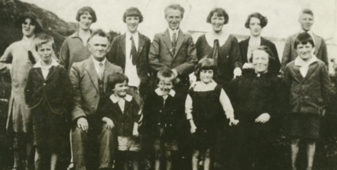
Turlough McConnell recounted his wild and mysterious summers in Kilcar, County Donegal in Irish America magazine.
A Living Legacy: Irish Art from the Collection of Brian Burns
A special supplement to Irish America by Turlough McConnell delving into  the genesis of Brian Burns’ collection of Irish art and the subsequent sale of his collection at the world-renowned London auction house, Sotheby’s in November 2018.
the genesis of Brian Burns’ collection of Irish art and the subsequent sale of his collection at the world-renowned London auction house, Sotheby’s in November 2018.
Click here to read more.
Irish Scholarship Landmark at Boston College
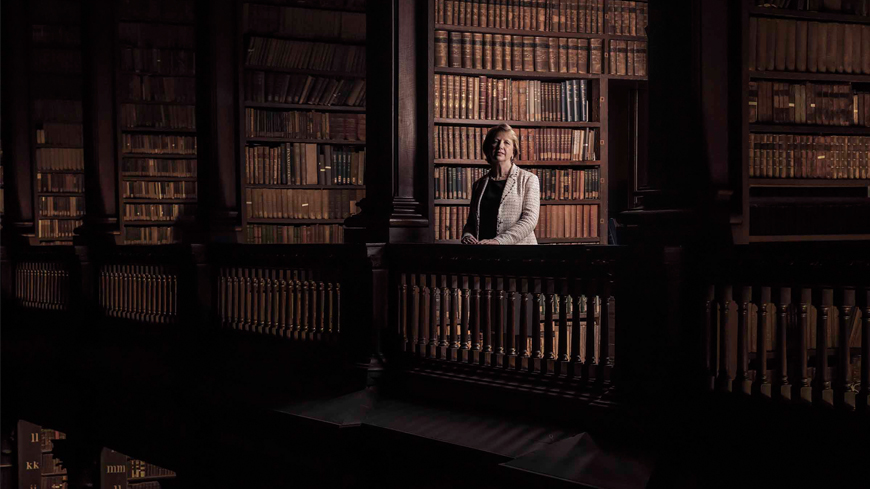
A special supplement to Irish America by Turlough McConnell celebrating the 25th anniversary of the Boston College’s Burns Visiting Scholar in Irish Studies Program. Featuring interviews with Mary McAleese, Mick Maloney, Nuala Ní Dhomhnaill, and more former Scholars. Original photography by Kim Haughton.
Click here to read more.
A Monumental Legacy: Archbishop John J.Hughes and the Building of St. Patrick’s Cathedral
Curated and produced by Turlough McConnell Communications for the Archdiocese of New York with generous support from CapTrust.
Design by Andrew Patapis
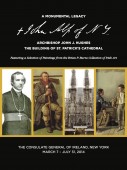 This brochure accompanied the eponymous exhibition held at the Consulate General of Ireland, New York from March 7 – July 31, 2014. The exhibition remains on view at the Basilica of Old St. Patrick’s Gallery in New York City’s historic SoHo arts district on the occasion of their Bicentennial Celebration.
This brochure accompanied the eponymous exhibition held at the Consulate General of Ireland, New York from March 7 – July 31, 2014. The exhibition remains on view at the Basilica of Old St. Patrick’s Gallery in New York City’s historic SoHo arts district on the occasion of their Bicentennial Celebration.
This is the extraordinary story of a towering 19th century Irish immigrant and the Famine Irish who built a New York landmark. In this brochure, the contributing historians Dr. Terry Golway, Professor Christine Kinealy, Dr. Maureen Murphy and the novelist Peter Quinn in association with Turlough McConnell Communications contribute a valuable work of scholarship on the life and legacy of Archbishop John J. Hughes.
Click here to view the brochure
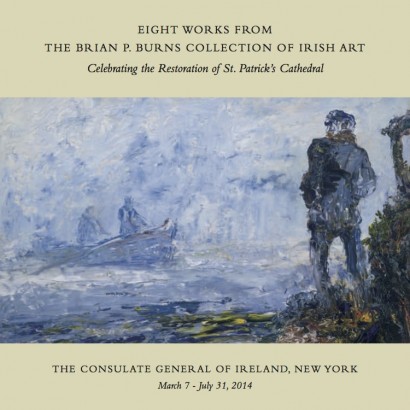 Eight Works from the Brian P. Burns Collection of Irish Art: Celebrating the Restoration of St. Patrick’s Cathedral
Eight Works from the Brian P. Burns Collection of Irish Art: Celebrating the Restoration of St. Patrick’s Cathedral
Produced by Turlough McConnell Communications
Design by Andrew Patapis
In conjunction with the exhibition “A Monumental Legacy,” the eight paintings featured in this brochure were exhibited at the Consulate General of Ireland, New York from March 7 – July 31, 2014. Curated by Dr. Éimear O’Connor, these works, from some of Ireland’s greatest masters, depict Ireland of the 19th Century. Including artists Jack B.Yeats, Seán Keating, James Brenan, Erskine Nicol, Maurice MacGonigal, George William (AE) Russell and F. J. Davis.
Click here to view the brochure
Celebrating 250 Years of the New York City St. Patrick’s Day Parade 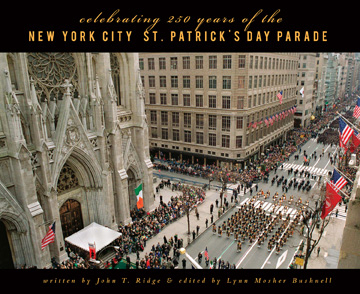
Associate Co-Publisher for Quinnipiac University
Through moving text crafted by John T. Ridge, one of New York City’s leading historians, this volume explores the past, present and future of Irish-American pride in a vivid celebration of the nation’s longest-running parade and the people and events who shaped it. The image of the long green line, gallantly marched by the descendants of the seven million who emigrated from Ireland to America over three centuries, illustrates the triumphs of a proud and passionate people.
Drawing from New York’s most precious photographic archives, editor Lynn Mosher Bushnell has assembled a visual history of the parade that unfolds page by page with hundreds of rare and extraordinary photographs. Celebrating 250 Years pays heartfelt tribute to the Irish in America. The annual parade reflects their strength, spirit and passion and contributes to the unique character of New York City.
Ireland’s Great Hunger Museum
Special Advisor/Executive Producer
Ireland’s Great Hunger Museum, Músaem an Ghorta Mhóir, is the world’s largest collection of art and sculpture relating to the catastrophe that devastated Ireland from 1845–52. There are only a handful of public institutions in Ireland that tell the story of Ireland’s Great Hunger. With the opening of this museum, there is now one in North America, home to so many generations of descendants of Famine immigrants.
The mission of the museum is to educate people of all ages, using world-class art, about that traumatic period of 19th-century Irish life. It is the vision of Quinnipiac University, and its president, John L. Lahey, that the museum will become a center of artistic and academic excellence—collecting great works of art, conducting tours and hosting discussions, films, plays, and concerts to showcase the richness of Irish culture and ideas.
Click here for more on the exhibition’s catalog
Special Features for Irish America Magazine
Contributing Writer/Producer

In his role as Contributing Director of Special Features for Irish America Magazine, special feature features, overseeing content, design and all aspects of production.
Click here to access the features
Turlough McConnell profiled in Derry Journal
September 11, 2012“Sometimes when you get chatting to a person who has emigrated from Ireland, you can catch a glimpse of our country’s own evolution over the last thirty or so years. That’s very much the case with Buncrana man Turlough McConnell, whose writing and music took him first to Dublin and then on to New York…”
Posted in news | Comments Off on Turlough McConnell profiled in Derry Journal ← Older posts Newer posts →